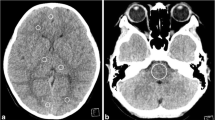Abstract
Objective
To explore the effectiveness of electro-acupuncture (EA) in the treatment of childhood autism (CA) and evaluate its effectiveness using single photon emission computed tomography (SPECT).
Methods
A total of 55 CA patients (4.52±2.73 years) were enrolled in this study. All patients received EA treatments and were examined by SPECT before and after treatments.
Results
Following treatment, the intracerebral multiple focal radioactivity distribution defect areas of CA patients were observed to be partially filled. Specifically, significant differences in the ratios of regional cerebral blood flow and global cerebral blood flow before (Fb) and after (Fe) EA treatment in different lesions were observed (in the left prefrontal cortex, t=5.01, P<0.01; in the right prefrontal cortex, t=2.32, P<0.05; in the left temporal lobe, t=4.54, P<0.01; in the right temporal lobe, t=2.90, P<0.05; in the left Broca’s area, t=5.82, P<0.01). After EA treatment, the patients exhibited symptomatic relief.
Conclusion
EA is useful to treat CA and SPECT can be used to evaluate the effectiveness of this treatment.
Similar content being viewed by others
References
Kanner L. Autistic disturbances of affective contact. Nervous Child 1943;2:217–250.
Amaral DG. The promise and the pitfalls of autism research: an introductory note for new autism researchers. Brain Res 2011;1380:3–9.
Harrington JW, Patrick PA, Edwards KS, Brand DA. Parental beliefs about autism: implications for the treating physician. Autism 2006;10:452–462.
Kogan MD, Blumberg SJ, Schieve LA, Boyle CA, Perrin JM, Ghandour RM, et al. Prevalence of parent-reported diagnosis of autism spectrum disorder among children in the US, 2007. Pediatrics 2009;124:1395–1403
Rice C. Prevalence of autism spectrum disorders: Autism and Developmental Disabilities Monitoring Network, United States, 2006. MMWR Surveill Summ 2009;58:1–20.
Ganz ML. The lifetime distribution of the incremental societal costs of autism. Arch Pediatr Adolesc Med 2007;161:343–349.
Stokstad E. Biomedical policy. New autism law focuses on patients, environment. Science 2007;315:27.
Xu H, Chen KJ. Acupuncture: a paradigm of worldwide cross-cultural communication. Chin J Integr Med 2011;17:163–165.
Guo HF, Tian J, Wang X, Fang Y, Hou Y, Han J. Brain substrates activated by electroacupuncture (EA) of different frequencies (II): role of Fos/Jun proteins in EA-induced transcription of preproenkephalin and preprodynorphin genes. Brain Res Mol Brain Res 1996;43:167–173.
Cho SY, Kim M, Sun JJ, Jahng GH, Kim HJ, Park SU, et al. A comparison of brain activity between healthy subjects and stroke patients on fMRI by acupuncture stimulation. Chin J Integr Med 2013;19:269–276.
Lee MS, Ernst E. Acupuncture for pain: an overview of Cochrane reviews. Chin J Integr Med 2011;17:187–189.
Huo ZJ, Guo J, Li D. Effects of acupuncture with meridian acupoints and three Anmian acupoints on insomnia and related depression and anxiety state. Chin J Integr Med 2013;19:187–191.
Brinkley J, Nations L, Abramson RK, Hall A, Wright HH, Gabriels R, et al. Factor analysis of the aberrant behavior checklist in individuals with autism spectrum disorders. J Autism Dev Disord 2007;37:1949–1959.
Mountz JM, Tolbert LC, Lill DW, Katholi CR, Liu HG. Functional deficits in autistic disorder: characterization by technetium-99m-HMPAO and SPECT. J Nuclear Med 1995;36:1156–1162.
Zhang R, Jia MX, Zhang JS, Xu XJ, Shou XJ, Zhang XT, et al. Transcutaneous electrical acupoint stimulation in children with autism and its impact on plasma levels of argininevasopressin and oxytocin: a prospective single-blinded controlled study. Res Dev Disabil 2012;33:1136–1146.
Jiang Y, Hao Y, Zhang Y, Liu J, Wang XY, Han JS, et al. Thirty minute transcutaneous electric acupoint stimulation modulates resting state brain activities: a perfusion and BOLD fMRI study. Brain Res 2012;1457:13–25.
Wilson JF. A reflection on the management and treatment of cervical spine neuropathies with East Asian medicine: acupuncture. Chin J Integr Med 2013;19:403–408.
Zhu TM, Li H, Jin RJ, Zheng Z, Luo Y, Ye H, et al. Effects of electroacupuncture combined psycho-intervention on cognitive function and event-related potentials P300 and mismatch negativity in patients with internet addiction. Chin J Integr Med 2012;18:146–151.
Lee MS, Choi TY, Kim JI, Kim L, Ernst E. Acupuncture for treating attention deficit hyperactivity disorder: a systematic review and meta-analysis. Chin J Integr Med 2011;17:257–260.
Guo HF, Cui X, Hou Y, Tian J, Wang X, Han J. C-Fos proteins are not involved in the activation of preproenkephalin gene expression in rat brain by peripheral electric stimulation (electroacupuncture). Neurosci Letters 1996;207:163–166.
Sugai GC, Freire AO, Tabosa A, Yamamura Y, Tufik S, Mello LE. Serotonin involvement in the electroacupuncture and moxibustion-induced gastric emptying in rats. Physiol Behav 2004;82:855–861.
Yano T, Kato B, Fukuda F, Shinbara H, Yoshimoto K, Ozaki A, et al. Alterations in the function of cerebral dopaminergic and serotonergic systems following electroacupuncture and moxibustion applications: possible correlates with their antistress and psychosomatic actions. Neurochem Res 2004;29:283–293.
Hamba M, Toda K. Effects of electroacupuncture on the neuronal activity of the arcuate nucleus of the rat hypothalamus. Exp Neurol 1985;87:118–128.
Han JS, Chen XH, Sun SL, Xu XJ, Yuan Y, Yan SC, et al. Effect of low- and high-frequency TENS on Met-enkephalin-Arg-Phe and dynorphin a immunoreactivity in human lumbar CSF. Pain 1991;47:295–298.
Zhang Y, Glielmi CB, Jiang Y, Wang J, Wang X, Fang J, et al. Simultaneous CBF and BOLD mapping of high frequency acupuncture induced brain activity. Neurosci Letters 2012;530:12–17.
Zhu WL, Li Y, Wei HF, Ren XX, Sun J, Zhang LF, et al. Effect of electro-acupuncture at different acupoints on neuropeptide and somatostatin in rat brain with irritable bowel syndrome. Chin J Integr Med 2012;18:288–292.
Aylward EH, Minshew NJ, Goldstein G, Honeycutt NA, Augustine AM, Yates KO, et al. MRI volumes of amygdala and hippocampus in non-mentally retarded autistic adolescents and adults. Neurology 1999;53:2145–2150.
Author information
Authors and Affiliations
Corresponding author
Additional information
Supported by the Science and Technology Research Project of State Administration of Traditional Chinese Medicine (No. 00-01LP11) and Shenzhen Science and Technology Project (Health and Medicine Class, No. 201102015)
Rights and permissions
About this article
Cite this article
Zhao, Zq., Jia, Sw., Hu, S. et al. Evaluating the effectiveness of electro-acupuncture as a treatment for childhood autism using single photon emission computed tomography. Chin. J. Integr. Med. 20, 19–23 (2014). https://doi.org/10.1007/s11655-014-1680-2
Received:
Published:
Issue Date:
DOI: https://doi.org/10.1007/s11655-014-1680-2




